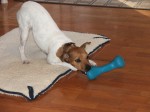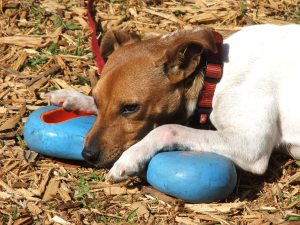
- Boudicca Fetch and Retrieve
Fetch and Retrieve
I happen to love teaching dogs fetch and retrieve for a couple of very important reasons. The first is this behavior is a building block for cooperation and what better way to teach a dog cooperation than getting him to willingly run after something, bring it back to you and then relinquish it! The second biggest reason is providing an outlet for dogs who commonly love to chase things, what better way to redirect predatory behavior than through interactive play with our pets.
Unfortunately, not all dogs get this training early in life. Studies show that dogs learn this behavior best beginning when they are 9 weeks old. However, this does not mean we can’t train this fun behavior, it just means we might need to put forth a little more effort. Also, I tend to think all dogs are capable of learning this simple game so don’t get discouraged just because your dog isn’t a natural born retriever.
You may also encounter other contributing factors that explain why dogs may be reluctant to play the game; some may be included in the following list.
- Motivation
- History involving inadvertent punishment, i.e. punished previously for picking up a shoe
- Lack of early learning
- Never introduced to toys
- Distractions
However, this doesn’t mean we should dismiss our dogs ability to learn this new skill, but rather we will just work harder to make it possible, keeping in mind we will gain ground in small increments that may be dependent on your individual dog.
How we approach this training will depend on your dogs’ previous history and all the things I have already pointed out. If we are beginning with a dog with little interest, we need to begin with the most basic step.
Toys first
If your dog already has a good history of playing with and interacting with toys, you may be able to skip ahead to the next level of learning. If your dog lacks a good history of playing with toys or even you, it might be necessary to begin at the most basic level. The idea is getting your dog in a playful mood and need to begin with an introduction to toys!
The following is a short list of suggested toys
- Balls all types and materials and large enough to not be swallowed
- Rope toys – great for tug of war
- Hard rubber toys such as Kong toys and similar products
- Interactive toys such as Buster Cubes, stuffed Kong items, hollow stuffed marrow bones and similar products
- Soft Toys – I love soft toys, but unless you are familiar with how your dog interacts with soft objects I consider them to be given only under supervision to avoid swallowing any of the materials contained in them
- I like to suggest having a large sampling of toy types including different materials and textures – dogs love novelty and keeping toys put away keeps them more interesting
- Safe chew items – ask your behavior consultant or professional trainer for suggestions
This is a very limited list and a very small sampling of available options. For more suggestions, ask your behavior consultant or trainer.
Beginning basics – Grade School
- Using one of your dog’s toys begin by rewarding any interest in the toy – if you are using click and treat, you will c/t every time your dog goes near the toy – this is shaping your dog toward the target behavior, your goal
- Throw the toy – your dog may chase it, if so c/t
- Tease him with the toy – this is my personal favorite
- Play peek-a-boo – hiding it behind your back
- If it squeaks, taunt him with it, this works great for terriers
- Reward any attempt to interact with the toy
- When he starts showing interest – put the toy away
-
Never get angry or frustrated – always keep the activity upbeat and fun
Identifying the chain
Before we can begin, we first must identify the chain of behavior required in fetch and retrieve. The following are the most basic steps in the behavior.
- Give – release item
- Take it – go fetch item
- Recall – return to you
The behavior is performed using the following sequence, but is learned by back chaining.
- Dog is in front position or along side of you using a wait cue
- Object is thrown
- Dog is cued to take it
- Dog returns (comes) to you
- Dog gives item to you
Take it
We first teach the dog what take it means as follows:
- Begin by offering your dog a treat, when he takes it c/t – do this about 8-10 times
- Next using 8-10 treats, offer him the treat, when he gets ready to take it, click and say the cue take it
- Once he is actively taking items in his mouth using the cue I like to begin introducing new items so the dog generalizes the behavior
- Maintain the excitement by keeping the retrieving objects put away in between training sessions
-
Keep your training sessions short, upbeat and end when the dog is still successful
Recalls – Sit – Wait
Recall, Sit and Wait should be part of your everyday training so this paper will not cover those training procedures. If you are not familiar with these training procedures, ask your behavior consultant or training professional for the applicable handouts.
Give (Release or Drop it)
This behavior is the opposite of take it and trained as follows:
- Begin first by offering a favorite toy to your dog
- When he takes it and has a firm hold, ask him to give or release offering him a treat at the same time
- The smell of the treat should immediately entice him to release the object
- When he releases quickly give him the treat repeating this 8-10 times
- When he is actively giving up the object, introduce the cue at the same time you offer the treat repeating this step 8-10 times
- Practice using different objects so he generalizes the behavior with many types of items, you may want to switch from using a treat in exchange for another similar toy or the exact same toy
- If you can’t get him to take a firm hold on the toy, you may have to shape this behavior separately
Secondary basics – Achieving higher levels
Once we have the foundation behaviors take it, give and recalls firmly in place we can precede to the next higher level of performance. Remember good training is done slowly and not proceeding before the dog is ready. Every dog will advance at their own pace and according to how much effort we put into their training, so don’t get discouraged if this takes more time than you expected, believe me it works or I wouldn’t be writing this.
- Start in low distraction environments this will prevent ruining any of our previously trained behaviors
- Make sure your dog is motivated and ready to play
- Rev him up if necessary
- Have plenty of treats
- Begin first by asking your dog to sit and wait
- Toss the toy a short distance away in front of the dog
- When you are ready ask him to take it
- Once he has taken the object in his mouth, using your recall encourage him to come using a happy tone of voice
- If he comes back, ask him to give offering him a treat at the same time
- Repeat this 3-5 times using the same distance
- Slowly increase the distance adding 5-10 feet depending on the dogs willingness and success at playing the game
- Repeat the behavior 3-5 times at every distance increase – you may even want to add additional repetitions
- If the dog shows any reluctance go back a step using a shorter distance and using more repetitions
- Use “slow dining” to reward excellent behavior
- Quit while your dog is successful
- Practice this every day slowly increasing the distance and repetitions necessary while building up the time spent performing the behavior
- Remember keep a smiley face on no matter how awkward your dog may seem
Slow dining is a form of jackpotting coined by Terry Ryan. What this means is rather than quickly rewarding for good behavior, slow things down and give multiple treats or prolonged praise making it last at least 15 – 30 seconds. This makes the reward more appetizing and furthers the bond between you and your dog.
Oh, those difficult dogs!
So you think you have one of those difficult dogs, well don’t get discouraged, here are a couple of helpful ways to get those less than willing retrievers to playfully go along with us.
- If your dog has taken to a particular toy, duplicate it and when you throw one, present the other enticing him back using this as a lure or bribe if you want to call it that, either way the object is to get your dog to learn *how* to be more cooperative and how much fun this new behavior is!
- If necessary use a long line – tossing your dogs favorite toy, when he firmly has it in his mouth gently reel him in but not pulling, calling him in your happiest tone of voice encourage him to come and when he arrives make sure you reward him for his good behavior.
Responsible Dog & Cat
Training and Behavior Solutions
Joyce D. Kesling, CDBC
Sarasota, Florida 34277
http://responsibledog.net
http://responsibledog.wordpress.com/
https://k9psych.wordpress.com/
http://k9psych.blogspot.com/
The greatness of a nation and its moral progress can be judged by the way its animals are treated. Mahatma Gandhi 1869 – 1948
Copyright Responsible Dog & Cat Rev A 2005 – 2009




